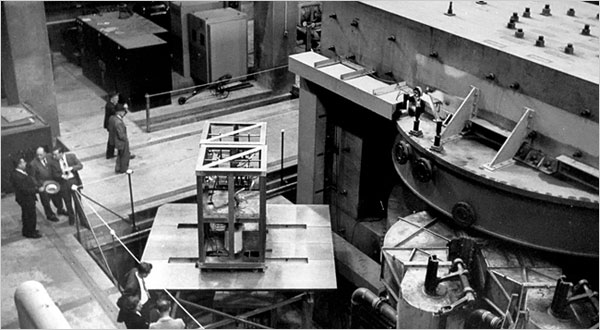Paul Doty (1920-2011) was an American biochemist.
He was born in Charleston, West Virginia on June 1, 1920. He received a Ph.D. in Chemistry from Columbia in 1944. While at Columbia, he conducted research on uranium isotope separation, which contributed to the Manhattan Project. This research sparked an interest in nuclear issues. Consequently, he started attending classes outside his main area of study taught by Enrico Fermi, Edward Teller, Isidor I. Rabi, Harold Urey, and others. After a few years researching in Brooklyn and Cambridge, England, Doty was appointed as an Assistant Professor of Chemistry at Harvard in 1948.
Arms Control Work
After the war, Doty was committed to limiting nuclear weapons and preventing their use. In 1953 and 1954, he worked with the Technological Capabilities Panel, which was founded by President Eisenhower to analyze the nuclear threat to the United States that could be posed by the Soviet Union.
Doty served as chairman of the Federation of American Scientists in the 1950s. In 1957, he was invited to represent the federation at the first “Pugwash Conference” in Pugwash, Nova Scotia to discuss the threat nuclear weapons posed to the world.
At Pugwash, Doty met with Soviet scientists. This gave him the idea that he could help prevent the use of nuclear weapons by working with his Soviet counterparts outside of official channels. In 1958, he travelled to the Soviet Union to discuss nuclear issues. This was his first of 42 such trips. He formed a National Academy of Sciences committee to facilitate research exchanges of Soviet and American scientists. He later convinced the Academy to create the Committee on International Security and Arms Control (CISAC).
In 1960 and 1961, he organized two Pugwash Conferences in the Soviet Union and the United States, respectively. Doty’s work gained him recognition in Washington. In 1961, he joined President John F. Kennedy’s Science Advisory Committee. As a member of the committee, Doty lobbied for the nuclear test ban treaty. In 1964, Doty established the Soviet-American Disarmament Studies group to lobby for arms control. This group’s work played a valuable role in negotiations that resulted in the Anti-Ballistic Missile Treaty of 1972.
In 1969, Henry Kissinger, a fellow Harvard professor, became President Nixon’s National Security Advisor. Doty urged Kissinger to create a small, informal advisory committee on nuclear issues. The “Doty group” met with Kissinger once a week and discussed a myriad of topics including ballistic missile defense, multiple independently-targeted reentry vehicles (MIRVs), and arms control agreements.
In 1973, Doty started a series of summer workshops at the Aspen Institute in Colorado to discuss arms control. He founded the Center for Science and International Affairs (later renamed the Belfer Center for Science and International Affairs) at Harvard in 1974 to analyze issues at the intersection of science and policy. With that goal in mind, Doty founded a quarterly-journal, International Security, in 1975.
Doty died on December 5, 2011 in Cambridge, Massachusetts at the age of 91.
Scientific Contributions
After leaving Columbia, Doty conducted research on the structure and behavior of molecules at the Polytechnic Institute of Brooklyn (now the Polytechnic Institute of New York University). His research was important in the design of better quality plastics.
In the late 1950s, Doty and fellow Harvard chemist, Julius Marmur, discovered that two separated DNA strands could be put back together. This finding led to a number of advances in the study of genetics.
In 1967, Doty founded the Department of Biochemistry and Molecular Biology at Harvard.





